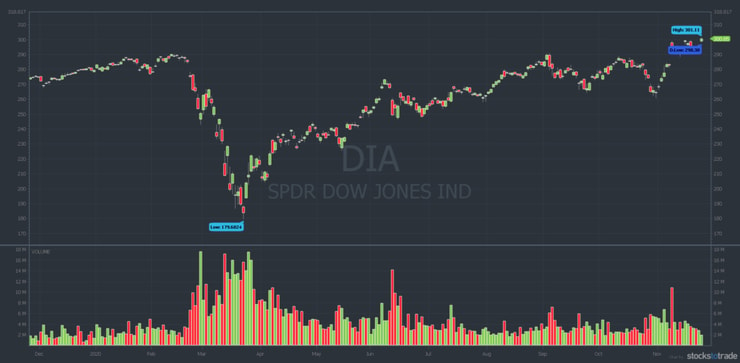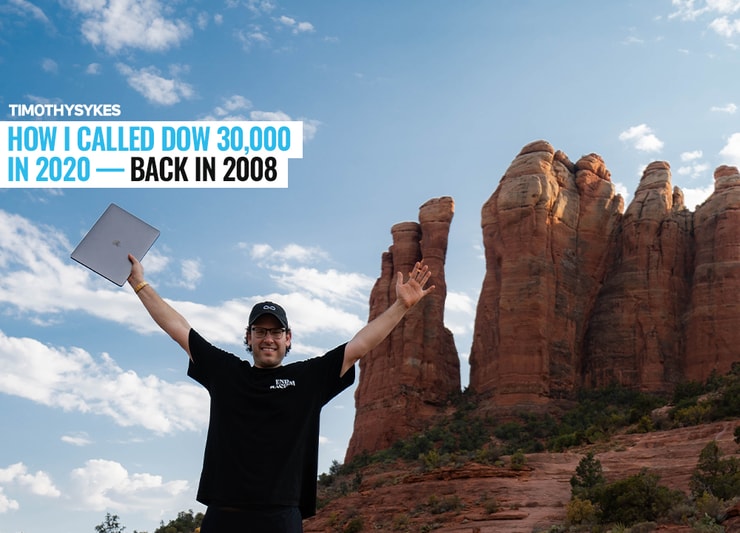Finally! The Dow 30,000 milestone fueled by a COVID-19 vaccine rally. What. A. Day. I LOVE it! Keep reading to see the video where I called Dow 30,000 back in 2008. (And why you shouldn’t try to predict the stock market.)
Check out the DIA ETF one-year chart…

This should make more people realize just how amazing this market is and that we’re living in a special time in history.
I really love this Dow 30k milestone as it should help more realize how amazing this market environment is…truly astounding how many opportunities there are every day lately, you better be profiting or at least learning, or both, whewwww! $DIA #stocks #stockmarket #bigmilestone
— Timothy Sykes (@timothysykes) November 24, 2020
Google Dow 30,000 and you’ll get nearly 15 million search results. From Forbes to MarketWatch, financial sites and blogs started writing about it in mid-January. That’s when the Dow first crossed 29,000. Everyone was making guesses about when it would cross 30,000. It’s a financial pundit’s dream to be the one to perfectly call it.
Check out these headlines from earlier this year:
From NBC news…
Table of Contents
- 0.1 The Dow at 30,000: What investors need to know
- 0.2 The Dow will hit a historic 30,000 sooner than you think
- 0.3 Dow 30,000! How It Happens In 12 Months (Or Less)
- 0.4 Charting the Approach of Dow 30,000
- 0.5 Forget Dow 30K. It’s Already Hit 40K on License Plates
- 1 How the Pandemic Spoiled the Dow 30,000 Party
- 2 TimRAW and Dow 30,000
- 3 Trading Challenge
The Dow at 30,000: What investors need to know
And from Fortune…
The Dow will hit a historic 30,000 sooner than you think
Here’s another from Investor’s Business Daily…
More Breaking News
- Upexi Stock Unexpectedly Surges: Here’s Why
- COIN’s Bold Moves: What Lies Ahead?
- PTEN Stock Plummets Amid Sector Concerns
Dow 30,000! How It Happens In 12 Months (Or Less)
MarketWatch used this headline…
Charting the Approach of Dow 30,000
And then there are the people out there who so badly want attention they buy vanity plates years in advance. The Wall Street Journal ran an article with this headline…
Forget Dow 30K. It’s Already Hit 40K on License Plates
Everyone wanted in on it. And why not? It was kinda cool that the stock market looked like it was ready to break through the milestone. It’s human nature to keep track of milestones. And it’s human nature to try to predict when it might happen.
How the Pandemic Spoiled the Dow 30,000 Party
If it wasn’t for the pandemic, the Dow might have hit 30,000 months ago. At first, the market seemed to shrug off the pandemic. Frankly, I was surprised. Then, as reality set in, the market crashed.
But crazy as it seems, the stay-at-home culture turned more people into day traders than at any time in history. We saw a beautiful bounce off the March 23 low that turned into the best 100 days in stock market history.
By early September, the Dow made it back over 29,000. Again, people started playing guessing games. Most pundits agreed it should happen within 12 months. But you’ve gotta remember that most of the time, the pundits are wrong.
Human Nature and Milestones
I don’t like guessing games or milestones. But it’s human nature. Not only do we like milestones…
… we’re addicted to predictions. Think about that for a moment. And there’s some evidence that people who make predictions don’t have to be right very often. Get it right once in a while and their followers believe every prediction they make.
The pundits on financial TV are a prime example. How often do you think they get it right? Not very. But we flick the switch on the television every day and listen to what they say.
They’ll tell you when they got it right….
Predicting DOW 30,000
I just have to sit back and laugh for a variety of reasons. But the big reason is…
I called Dow 30,000 in 2020 … back in 2008.
I know that sounds weird, and it is. Anyone who’s followed me for a while knows I don’t make predictions about the market and I don’t like guessing games.
I’ll come back to it. First, let’s take a look at ‘Dow 30,000’ specifically as a way to demonstrate why you shouldn’t believe what the pundits say…
The headlines I showed you above are just a few of many thousands you can find at the top of recent articles on the internet, in newspapers, magazines, etc.
But they’re not even close to being the first to predict Dow 30,000.
Check this out…
In May 2018, Gene Simmons, the lead singer of KISS, was interviewed by Barron’s. In the interview he said, “there is no question in my mind we are going to go past 30,000.” He didn’t give a date, during that interview. But in another interview with a well-known bald guy you see regularly on financial TV he said “probably within two years.”
Kudos … maybe an old rocker is a better judge of the markets than the so-called experts and financial analysts who’ve been predicting Dow 30,000 for far longer.
Like this guy…
In 2008, Robert Zuccaro authored a book titled “Dow 30,000 by 2008: Why It’s Different This Time.” Zuccaro is a chartered financial analyst who used to run a mutual fund called the Grand Prix Fund. It folded eventually. I think you can still buy used copies of this book if you want to understand the guy’s thinking.
But it goes even further — which is how this post came about.
Here’s how it happened…
TimRAW and Dow 30,000

In late 2008, I recorded my DVD guide called “TimRAW.” In the first DVD, I did a book review.
You might know that when I first got started I read every book in my dad’s vast financial library. So I wanted to review some of the books and give recommendations for students.
Quick aside here … you have to read a whole bunch of stuff if you want a solid background. Many people don’t want that broad of an education. I think that the more you study and the better you prepare, the better your chances of success. Preparation is key.
Also, if you have a broad background you might find a different strategy is better for you. While I want to be the mentor to you that I never had, I really only teach pennystocking. So if you find a different niche or strategy is better for you, that’s ok. (New to penny stocks? Start here with my FREE penny stock guide.)
Back to how I called Dow 30,000 in 2020…
So, when I got to the book “The Next Great Bubble Boom” by Harry Dent, I kinda joked about it. He predicted the Dow could get to 40,000 by 2010. I said maybe we’d get Dow 30,000 by 2020.
(As an Amazon Associate, we earn from qualifying purchases.)
Here’s my Dow 30,000 call…
How’s that for a call? But I hope you understand the important lesson there … You can learn a lot from people who are wrong.
Mark this date on your calendar, because you are witnessing a historic milestone.
November 24, 2020: The Dow Hits the 30,000 Milestone
After its 38% drop in February and March, it looked unlikely that my ‘prediction’ would come true. But it did. I’ll take it as long as you get the most important lesson of this post…
Don’t play guessing games. Don’t try to predict the market. Learn my strategies and rules, and then react to what the market gives. (I trade using these rules.)
That’s EXACTLY what all my top students are doing…
Trading Challenge
2020 has been crazy. It’s my best year ever. So far I’ve made $969,870 in trading profits*, all of which I donate to charity. And while I’m excited to make more to donate, I’m more proud of my students.
Jack Kellogg is my latest millionaire student.* Roland Wolf also passed the $1 million milestone in 2020.* Matthew Monaco has made over $418,000.* Kyle Williams is over $561,000 in trading profits — $435,400 in 2020 alone.*
(*Please note: These results are far from typical. Individual results will vary. Most traders lose money. My top students and I have the benefit of years of hard work, dedication, and experience. Trading is inherently risky. Do your due diligence and never risk more than you can afford to lose.)
What do these traders have in common? All my top students are in the Trading Challenge. Every single one.
The Trading Challenge is my most comprehensive program. Everything I’ve learned over two decades of trading and 12 years of teaching is there for you. But you have to want it. Dedication and study are the keys to freedom.
Why You Should Apply for the Trading Challenge Today
Here’s what you get as a Trading Challenge student…
- Thousands of video lessons. These video lessons are like a running documentary on trading strategies working at any given time. Thanks to millionaire student Mark Croock, they’re all categorized. That way you can focus on one strategy at a time.
- Hundreds of archived webinars. Want to learn how to trade like the OG Tim Grittani? Watch his more than 60 webinars in the archives. Nuggets of gold.
- Live webinars. Every week, Trading Challenge students get two to four live webinars. Every webinar features Q&A. Some show live trading. Others are trade reviews showing the best trades from each of the Challenge mentors.
- Trading Challenge chat. My favorite chat room anywhere. During market hours, you’ll see trade alerts by all the top traders in the Challenge. When you study their trades in real time (NEVER trade based on an alert) you start to understand their thought process.
- Hundreds of hours of DVD guides. This is the foundation for your trading education. From learning to read SEC filings, to understanding level 2, all the basics are here. (HINT: Watch TimRAW disc 1 at the 1:49:35 mark to see my Dow 30,000 2020 prediction. Woo hoo!)
- Daily watchlists. Learn how I make my watchlist and my thought process for potential trades.
- Trade Alerts. Again, NEVER follow me, or anyone else, into a trade. That said, if you watch my alerts and pick apart my trades, it can potentially speed up your learning curve.
- Access to the 30-Day Bootcamp. This is my most recent guide. It’s getting such rave reviews that we’ve made it part of the Trading Challenge orientation. BOOM.
You ready?
Apply for the Trading Challenge here
What do you think of the Dow 30,000 milestone and my crazy ‘prediction’ in 2008? Comment below … I love to hear from all my readers!









Leave a reply